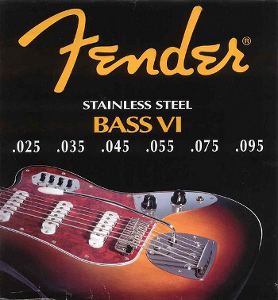Manufacturer Fender Neck joint Bolt-on Body Alder | Body type Solid Scale 30" | |
 | ||
Period 1961–1975, 2006, 2013–present | ||
The Fender Bass VI, originally known as the Fender VI, is a six-string electric bass guitar made by Fender.
Contents
Design concept and history
The Fender VI was released in 1961 and followed the concept of the Danelectro six-string bass released in 1956, having six strings tuned E to E, an octave below the Spanish guitar. The Bass VI was closely related to the Fender Jaguar, with which it shared styling and technical details, notably the Fender floating tremolo. The VI had an offset body similar but not identical to that of the Jazzmaster/Jaguar.
It departed from the concept of the Fender Precision Bass in having six strings, a shorter scale and thinner strings, and a mechanical vibrato arm. The Bass VI never caught on to the extent that the four-string Precision Bass and its derivatives did. The model was discontinued in 1975.
Reissue
In 2006, the Fender Custom Shop released a re-creation of the Bass VI, featuring three single-coil pickups and identical electronics. This format was previously available as a 1962 vintage reissue model made by Fender Japan in 1995.
In 2013 Fender released a Bass VI model as part of its Pawn Shop series. In line with the series' purpose to reconfigure classic Fender designs, the new Bass VI has a bridge humbucker and a Stratocaster-style five-position pickup selector instead of multiple switches. There are three available colors: brown sunburst with a tortoiseshell pickguard, black with a tortoiseshell pickguard, and candy-apple red with a white pickguard and painted headstock.
Also in 2013, Squier released a Bass VI as part of the Vintage Modified series. This model was similar to the traditional Bass VI design with four switches (on/off for each pickup and a strangle switch) and a Jaguar-style control plate. It continued the trend set by the Squier Vintage Modified Jaguars and Jazzmasters of having a non-locking tremolo plate. It is available in a three-color sunburst finish, Olympic White with a brown tortoiseshell pick guard and black with a white pickguard.
Specifications
Like other Fenders of the time, the Fender VI had a 7.25-inch fingerboard radius. The Fender VI, along with the Jaguar, the Jazzmaster and the Electric XII, was given a bound fretboard with rectangular block inlays in 1967, followed by a thicker black CBS-style headstock decal and polyester finishes instead of nitrocellulose lacquer in 1968.
Electronics
The original issue Bass VI had three Stratocaster-style single coil pickups (although the internal construction was more similar to the Telecaster's bridge pickup with its metal base and mounting screws), which were mounted in special chrome rings and were controlled by a panel of three on/off slider switches rather than the conventional three-position switch.
When the Fender Jaguar was released in 1962, it used the Jazzmaster body with its unusual lead/rhythm electrics and the floating tremolo, but with a short scale-length neck, the Bass VI switch panel and two unique "toothed" pickups. With only two pickups to control, on the Jaguar the third slider switch served as a bass cut (also known as "strangle") switch.
In 1963, the Bass VI electronics were revised to incorporate some features from the Jaguar, with the adoption of toothed pickups and the addition of a fourth slider switch to provide bass-cut. This remained the setup of the Bass VI throughout its remaining 12 years of continuous production.
Electronics mentioned above were all passive electronics.
Vibrato arm
The vibrato arm was the floating type with a locking device. This mechanism was developed for the Fender Jazzmaster and also used on the Fender Jaguar. It was more elaborate than the synchronised tremolo of the earlier Fender Stratocaster, and was claimed by Fender to be superior, but it failed to achieve the same popularity. Unlike the synchronised tremolo, it was rarely copied by other makers and disappeared from the Fender catalogue with the withdrawal of the Jaguar line in the 1970s. It has since appeared mainly on Fender reissues.
Related instruments
In 2004, Fender issued the Fender Jaguar Baritone Custom (later renamed "Jaguar Bass VI Custom"), which in format was a combination of the Bass VI and the Fender Jaguar. The Jaguar Baritone Custom used the same string gauges and tuning as the Bass VI, but differed in that it has a Jaguar-shaped body, two pickups with Jaguar-style switching options, a fixed bridge and a shorter 28.5-inch scale length.
Reviews
Brian Molko and Stefan Olsdal of Placebo play Fender Bass VIs, with Molko saying, "Playing the Fender VI is like playing two instruments in one, it can be treated as a guitar and as a bass. When Stefan is playing lead parts on the Fender Bass VI, he's also using his feet to play a bassline with Taurus pedals. I think if Stefan were an octopus, he'd be playing even more instruments."
Producer Mike McCarthy talked about using the Fender Bass VI on records in a December 2007 Mix Magazine article.
